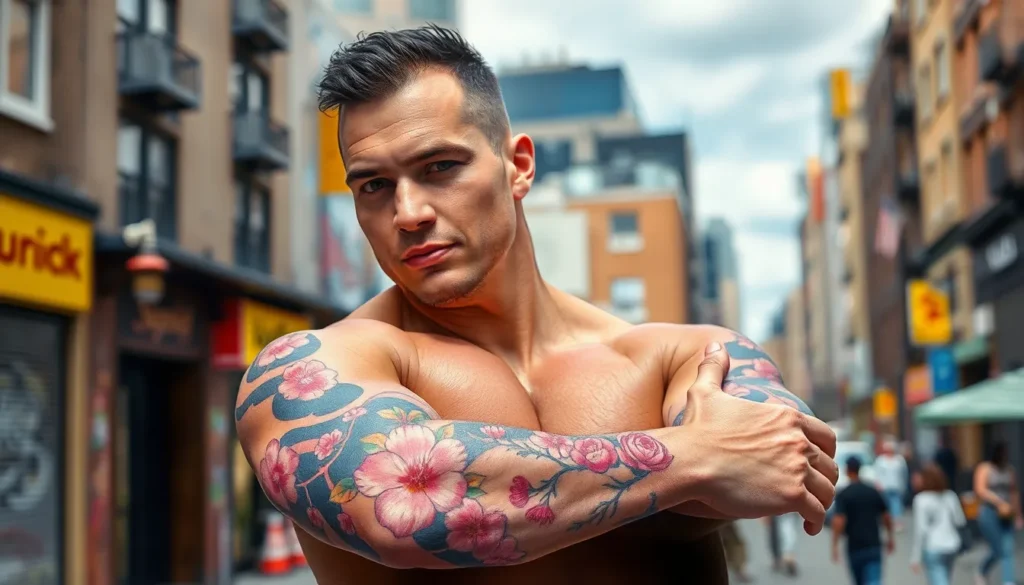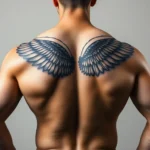Japanese flower tattoos aren’t just delicate artwork reserved for feminine designs – they’re powerful symbols that make stunning masculine ink. We’ve seen countless men embrace these botanical masterpieces that blend traditional Japanese artistry with bold, meaningful symbolism.
Cherry blossoms represent life’s fleeting beauty while chrysanthemums symbolize honor and loyalty. Lotus flowers embody rebirth and strength through adversity. These aren’t just pretty petals – they’re profound statements that resonate with men seeking tattoos with deeper significance.
We’re breaking down everything you need to know about Japanese flower tattoo designs for men. From understanding the cultural meanings behind each bloom to discovering placement ideas that maximize visual impact, we’ll help you choose the perfect floral design that speaks to your story while honoring this timeless art form.
Traditional Cherry Blossom Tattoos for Masculine Appeal
Cherry blossoms offer men a perfect balance of delicate beauty and powerful symbolism in traditional Japanese tattoo art. We’ve explored how these sakura designs can create striking masculine tattoos that honor the fleeting nature of life.
Bold Sakura Sleeve Designs
Bold sakura sleeves transform the entire arm into a canvas celebrating life’s ephemeral beauty. These expansive designs typically feature large cherry blossom branches cascading from shoulder to wrist, creating dramatic visual impact. We recommend incorporating traditional elements like flowing water, rocks, or wind bars to enhance the masculine appeal of full sleeve compositions.
Layered sakura branches create depth and movement in bold sleeve applications. Artists often use varying sizes of blossoms, from fully opened flowers to tight buds, establishing natural progression across the arm. The traditional approach includes darker branch work with lighter pink and white petals, allowing the design to maintain masculine strength while showcasing delicate floral elements.
Color saturation plays a crucial role in bold sakura sleeve execution. Deep pinks, vibrant whites, and rich browns create stunning contrast against skin tone, making these designs visible from considerable distances. We’ve observed that bold sakura sleeves work exceptionally well on muscular arms, where the natural contours enhance the flowing nature of cherry blossom branches.
Minimalist Cherry Blossom Accents
Minimalist cherry blossom accents provide subtle masculine elegance without overwhelming the wearer. These smaller designs typically feature single branches with 3 to 5 blossoms, placed strategically on forearms, shoulders, or behind the ear. We find that minimalist sakura tattoos appeal to men seeking meaningful symbolism in compact, refined presentations.
Single stem designs emphasize the essential beauty of cherry blossoms in masculine contexts. Artists create these pieces using clean lines and simple shading techniques, focusing attention on the natural curves of branches and petal formations. The minimalist approach allows men to incorporate Japanese floral symbolism without committing to larger, more complex compositions.
Placement versatility makes minimalist cherry blossom accents incredibly popular among professional men. These designs work effectively on wrists, ankles, or ribcage areas where they can be easily concealed when necessary. We’ve noticed that many men choose minimalist sakura tattoos as their first introduction to Japanese floral imagery, often expanding to larger pieces later.
Black and Gray Cherry Blossom Styles
Black and gray cherry blossom styles offer timeless masculine appeal through monochromatic artistry. These designs eliminate color completely, relying on shading gradients and line work to create stunning visual impact. We appreciate how black and gray sakura tattoos maintain traditional Japanese aesthetics while providing versatile options for men who prefer subtle ink choices.
Shading techniques in black and gray sakura create remarkable depth and dimension. Artists use various gray tones to distinguish petals from branches, often incorporating traditional Japanese wind patterns or water elements to enhance overall composition. The monochromatic approach allows for intricate detail work that might be lost in colorful versions.
Traditional sumi e painting influences enhance black and gray cherry blossom authenticity. These designs often incorporate brushstroke effects and ink wash techniques that mirror classical Japanese art forms. We recommend working with artists experienced in traditional Japanese tattooing to ensure proper execution of black and gray sakura pieces, as the style requires exact technical skills to achieve authentic results.
Powerful Chrysanthemum Tattoo Concepts
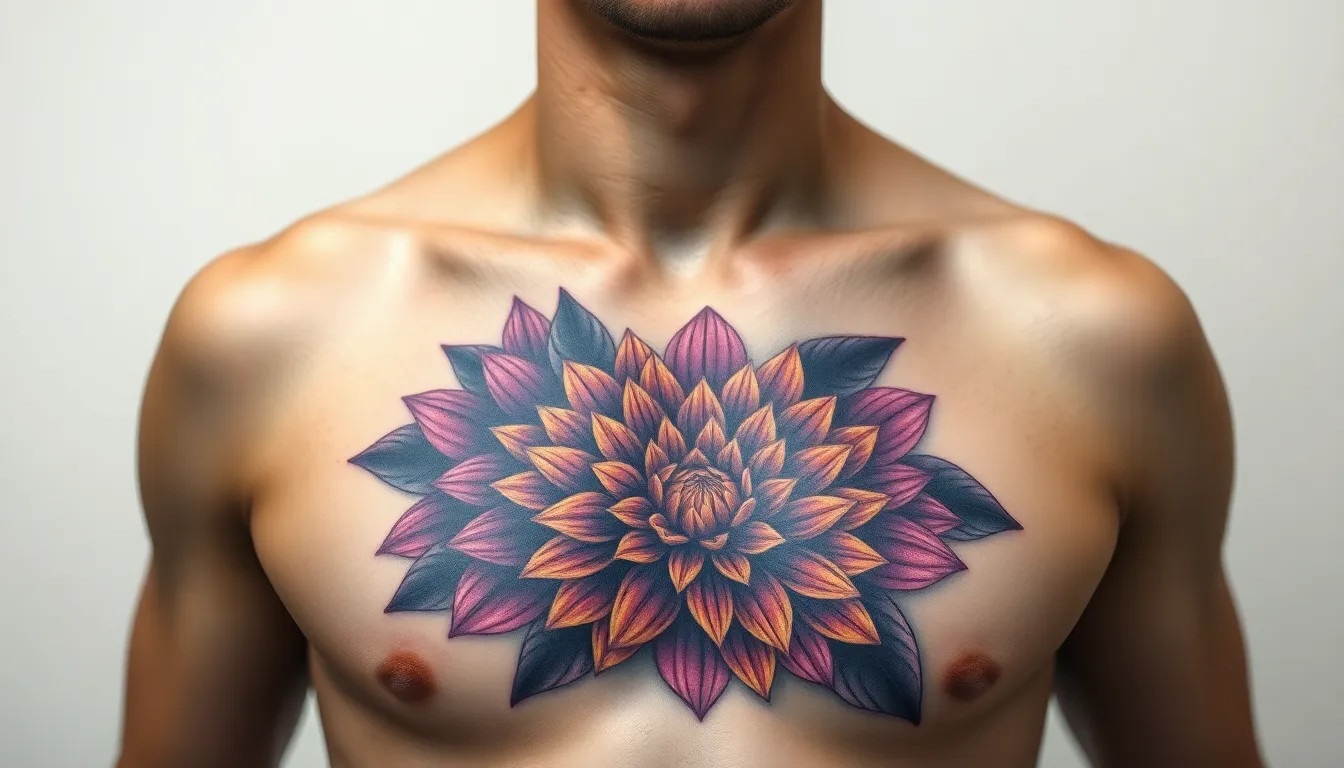
Chrysanthemum tattoos represent some of the most meaningful Japanese floral designs available to men today. These intricate flowers symbolize longevity, nobility, beauty, loyalty, honor, and resilience while carrying deep connections to Japanese Imperial Family traditions and samurai heritage.
Imperial Chrysanthemum Chest Pieces
Imperial chrysanthemum chest tattoos showcase the prestigious Chrysanthemum Crest known as “Kiku no mon” featuring sixteen stylized petals. This sacred symbol represents the Japanese Imperial Family and transforms the chest into a canvas of royal significance. Bold placement across the chest emphasizes strength and cultural pride while honoring Japan’s most revered floral emblem.
We recommend incorporating traditional color palettes of deep purples, golds, and vibrant yellows to capture the imperial essence. Large scale designs work exceptionally well in this placement, allowing artists to showcase intricate petal details and symbolic depth. Historical connections to the imperial throne make these tattoos powerful statements of respect for Japanese heritage and personal honor.
Geometric Chrysanthemum Arm Bands
Geometric chrysanthemum arm bands blend traditional Japanese artistry with contemporary design elements for striking visual impact. Sharp symmetrical lines intersect with natural chrysanthemum curves, creating balanced compositions that appeal to modern sensibilities. These fusion designs honor classical symbolism while expressing individual creativity and contemporary aesthetic preferences.
We’ve observed increasing popularity of these designs among men seeking cultural authenticity with modern flair. Clean geometric patterns frame the organic flower shapes, emphasizing both the mathematical precision and natural beauty inherent in chrysanthemum forms. Blackwork techniques often enhance the contrast between geometric elements and floral details, resulting in arm bands that command attention while maintaining sophisticated appeal.
Traditional Kiku Flower Back Tattoos
Traditional kiku flower back tattoos offer expansive canvases for detailed chrysanthemum artwork rooted in Edo period tattoo traditions. Back placement allows for large scale compositions that often incorporate complementary Japanese motifs like dragons, waves, or wind patterns. These comprehensive designs honor the historical legacy of samurai and working class individuals who used tattoos to express personal identity and cultural beliefs.
We recommend collaborating with artists experienced in traditional Japanese tattooing techniques to achieve authentic results. Large back pieces can showcase the full symbolic power of chrysanthemums while incorporating elements that enhance their protective qualities. Historical records indicate that firemen and other professionals in dangerous occupations favored chrysanthemum tattoos for their believed ability to ward off evil spirits and provide spiritual protection.
Striking Lotus Flower Japanese Designs
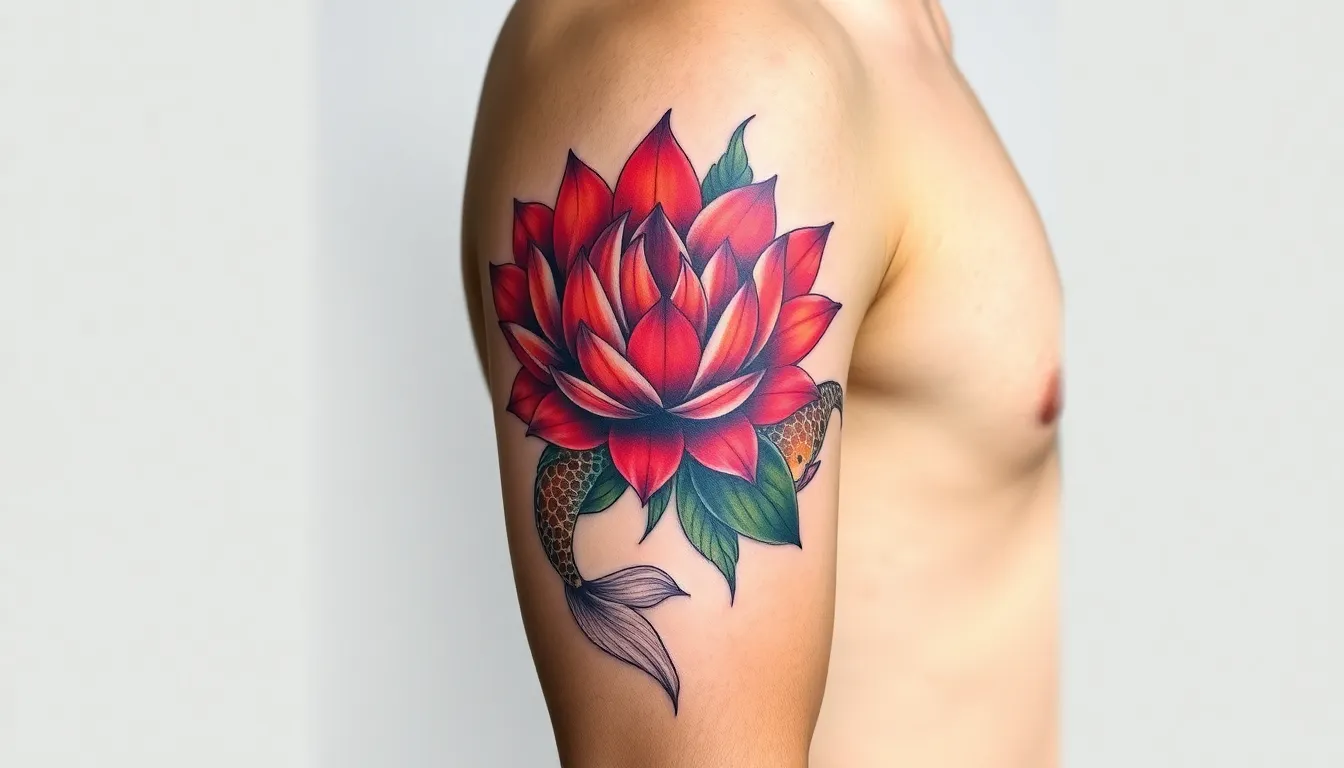
Lotus flowers stand among the most spiritually important motifs in Japanese tattoo art, symbolizing purity, enlightenment, and rebirth rising from muddy waters. We’ve seen these designs transform masculine aesthetics through bold colors, intricate line work, and deep cultural meaning that resonates with men seeking powerful floral symbolism.
Full Back Lotus Masterpieces
Full back lotus tattoos create dramatic visual statements that showcase the flower’s complete spiritual journey from darkness to light. These masterpieces typically feature the lotus in full bloom, surrounded by flowing water or traditional wave patterns that add ever-changing movement and depth to the entire composition. Artists use the expansive back canvas to incorporate detailed shading techniques, vibrant color palettes, and complementary elements like koi fish or traditional clouds. Bold reds, deep purples, and rich blues dominate these designs, creating striking contrasts against skin tone while emphasizing the lotus’s sacred symbolism. Large scale artwork allows for intricate petal details, realistic water droplets, and seamless integration with traditional Japanese background elements that tell complete visual stories.
Forearm Lotus and Koi Combinations
Forearm tattoos blending lotus flowers with koi fish represent classic Japanese storytelling through ink, combining symbols of purity and perseverance. These designs create balanced narratives where the lotus represents spiritual growth rising above adversity while koi symbolize strength and determination swimming upstream. Artists typically position the lotus as the focal point with koi swimming around or beneath the blooming flower, using fluid patterns that harmonize both elements within the forearm’s natural contours. Bright oranges, vibrant reds, and deep blues bring these combinations to life, while flowing water elements connect the symbols seamlessly. Smaller scale placement requires careful attention to proportion and detail, ensuring both the lotus and koi maintain their individual significance while creating unified artwork that tells a complete story of resilience.
Shoulder Lotus Mandala Fusion
Shoulder lotus tattoos fused with mandala patterns merge traditional Japanese artistry with geometric spirituality, creating designs that convey balance and inner peace. These fusion pieces use the lotus’s organic curves as the centerpiece while surrounding it with symmetrical mandala elements that enhance the flower’s spiritual symbolism. Artists position these designs to flow naturally with the shoulder’s rounded shape, allowing both modest coverage and extended artwork that can wrap around the arm or connect to chest pieces. Detailed line work creates intricate geometric patterns that complement the lotus’s soft petals, while strategic shading adds depth and dimension to both elements. Black and gray ink often dominates these designs, though subtle color accents in the lotus petals can create striking focal points that honor both artistic traditions.
Dynamic Peony Tattoo Arrangements
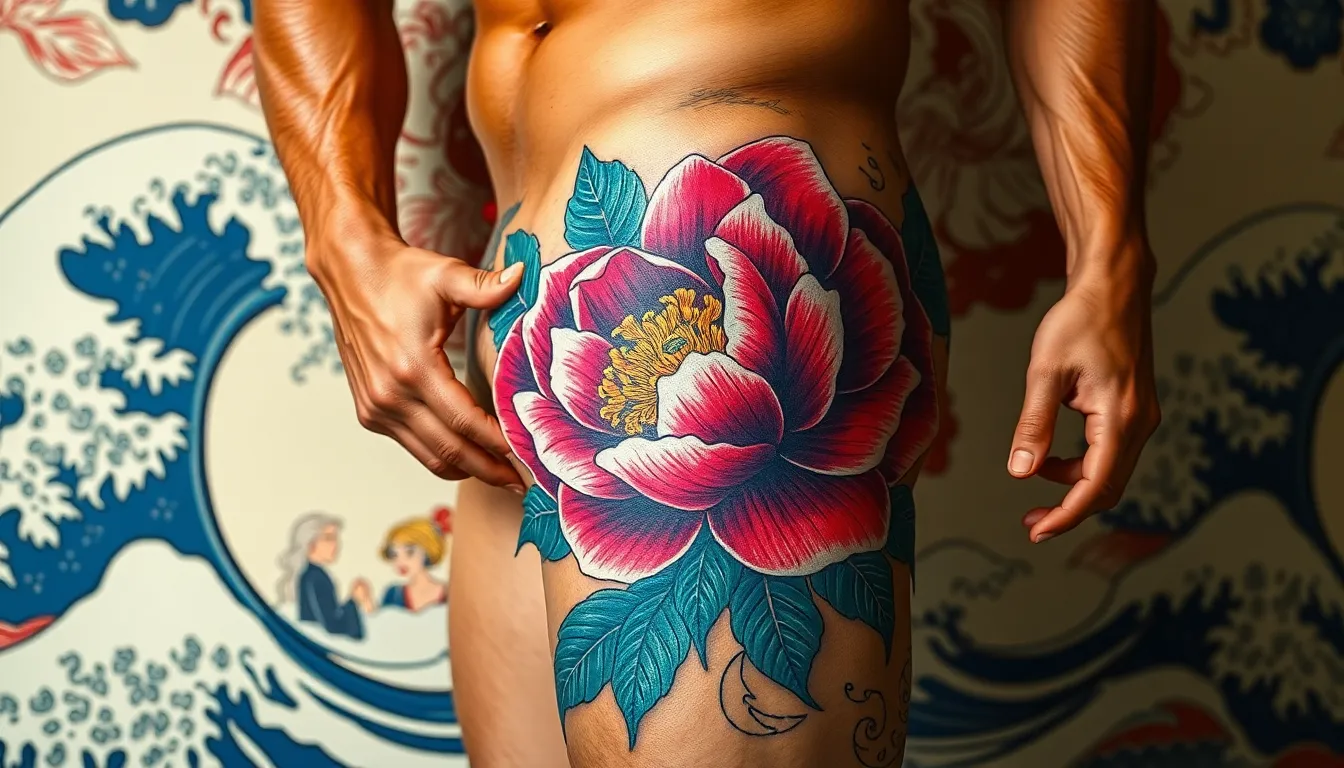
Peonies represent wealth, bravery, and honor in Japanese tattoo tradition, offering men powerful floral designs that emphasize natural movement and masculine elegance. These intricate arrangements showcase layered petals that flow dynamically with body contours, creating bold artistic statements that blend strength with beauty.
Large Scale Peony Thigh Tattoos
Thigh placements provide expansive canvases perfect for detailed peony masterpieces that demand attention and space. Artists use this generous surface area to create intricate petal work and sophisticated shading techniques that bring dimensional depth to each bloom. Traditional Japanese wave patterns and wind motifs often serve as compelling background elements that enhance the overall composition.
Bold floral statements emerge when peonies fill the entire thigh space, allowing for elaborate detailing that smaller placements can’t accommodate. We recommend these large scale designs for men seeking dramatic visual impact while maintaining the elegant symbolism of prosperity and resilience. Skilled tattoo artists can incorporate multiple peony blooms at varying stages of opening, creating natural storytelling through different flower phases.
Peony and Dragon Collaborative Designs
Dragons paired with peonies create powerful collaborative artwork that balances mythical strength with delicate beauty. These designs typically showcase fierce dragon energy representing protection and power, while peonies add symbolic depth through their associations with honor and bravery. Storytelling becomes central to these complex compositions, often spanning entire sleeves or back pieces.
Balance defines the relationship between dragon scales and peony petals, with each element improving the other’s visual impact. Artists frequently position dragons weaving through or around blooming peonies, creating ever-changing movement that follows natural body lines. We’ve observed these collaborative designs resonate strongly with men who appreciate both strength and artistic refinement in their tattoo choices.
Complex sleeve arrangements allow for extensive detail work where dragons and peonies can occupy equal visual weight. Back pieces offer even more canvas space for elaborate storytelling scenes that incorporate additional traditional elements like clouds, waves, or wind patterns.
Colorful Botan Flower Sleeves
Botan flower sleeves showcase vibrant traditional irezumi techniques that bring Japanese peonies to stunning life through elaborate color work. Bright color palettes combined with sophisticated shading create visually striking full arm compositions that honor cultural heritage while making bold personal statements. Traditional elements like waves, clouds, and samurai motifs frequently complement these floral designs.
Cultural meaning runs deep in botan sleeve tattoos, with prosperity and resilience symbolism woven throughout the artistic composition. We’ve seen skilled artists incorporate traditional color schemes that reference historical Japanese art, using authentic pigment choices that respect the irezumi tradition. Modern tattoo techniques enhance these classical designs while maintaining their cultural authenticity.
Detailed shading work distinguishes exceptional botan sleeves from average floral tattoos, requiring artists experienced in traditional Japanese methods. Full arm coverage allows for comprehensive storytelling where multiple peonies can represent different life phases or personal achievements. These sleeve designs typically require multiple sessions to achieve the level of detail and color saturation that makes them truly exceptional.
Elegant Camellia Flower Ink Ideas
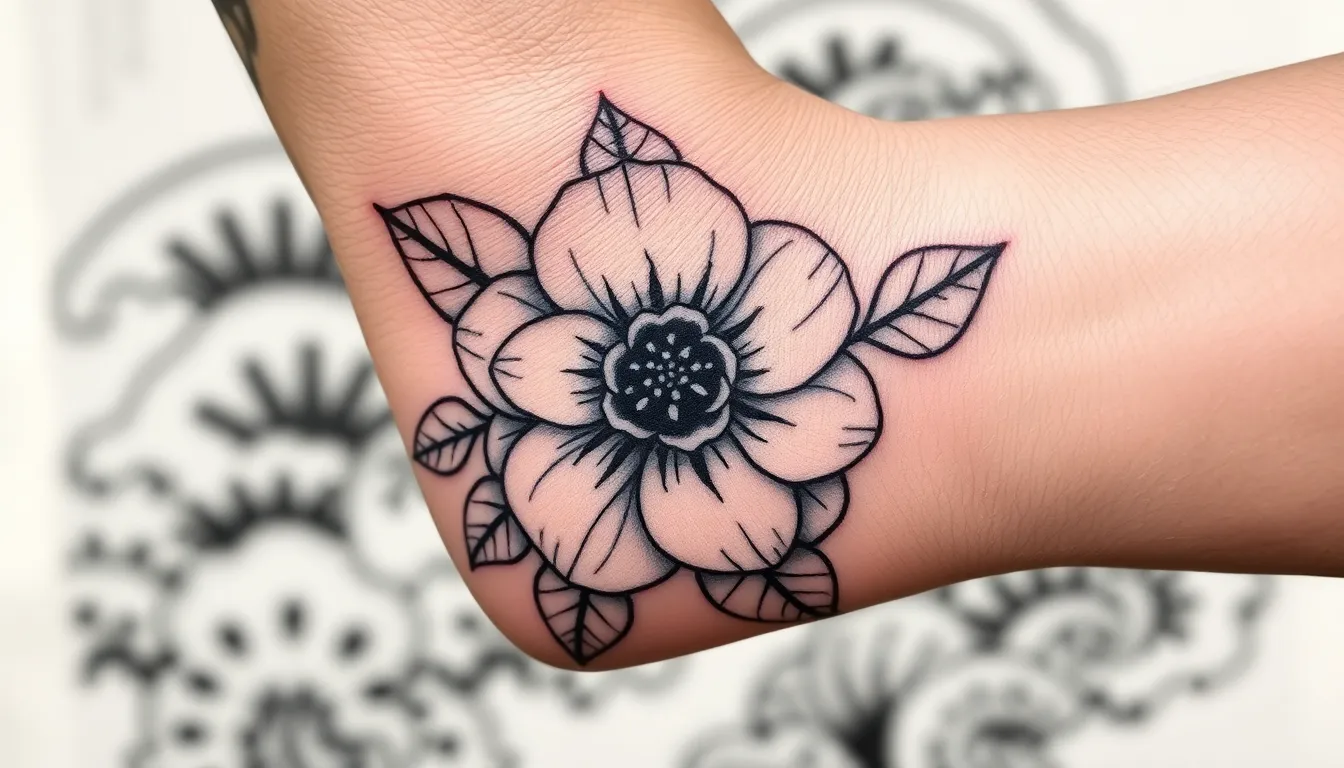
We’ve discovered that camellia flowers, known as tsubaki in Japanese culture, represent admiration, perfection, and love while offering sophisticated design possibilities for men. These elegant blooms provide masculine appeal through their clean, rounded petals and rich cultural significance.
Subtle Tsubaki Wrist Tattoos
Wrist placements for tsubaki tattoos deliver refined elegance without overwhelming masculine aesthetics. Professional men often choose these discreet designs because they carry important cultural weight while maintaining workplace appropriateness. Black and gray rendering creates minimalist effects that honor the flower’s delicate beauty without appearing overly flashy.
Small scale designs on the wrist allow for precise detailing of the camellia’s characteristic rounded petals. Artists can emphasize sharp lines and subtle shading to create sophisticated pieces that work as standalone tattoos. Muted color palettes maintain masculine appeal while celebrating the flower’s natural beauty and cultural importance.
Camellia and Samurai Themed Pieces
Combining camellia flowers with samurai imagery creates powerful thematic compositions that celebrate both beauty and warrior spirit. These designs reflect the duality of elegance and strength, honoring masculine qualities like courage and honor alongside refinement. Traditional Japanese tattoo art frequently pairs floral motifs with symbols of valor to create meaningful narratives.
Samurai figures positioned alongside camellia blooms tell stories of balanced masculinity in Japanese culture. Artists often incorporate traditional armor elements, katana swords, or warrior masks to enhance the piece’s strength symbolism. The camellia’s presence softens the composition while maintaining its significance as a symbol of daring and good fortune.
Background elements like cherry blossoms or traditional wave patterns can enhance these collaborative designs. Shading techniques borrowed from traditional sumi e painting add depth and authenticity to the overall composition. Color choices typically favor earth tones and muted palettes to maintain the design’s masculine appeal.
Monochromatic Camellia Designs
Black and gray camellia tattoos provide timeless masculine appeal through monochromatic artistry that emphasizes form and texture. These designs highlight the flower’s natural contours without color distractions, creating bold statements through expert shading techniques. Professional tattoo artists use various gray tones to create depth and dimension in the petals.
Traditional sumi e painting influences guide the shading approach in monochromatic camellia pieces. Artists focus on capturing the flower’s essence through strategic light and shadow placement rather than relying on color saturation. This technique creates sophisticated pieces that appeal to men seeking classic yet striking tattoo designs.
Texture work becomes crucial in monochromatic designs where artists must convey the camellia’s softness through ink gradation. Background elements like traditional clouds or minimalist geometric patterns can enhance the overall composition. These timeless pieces work exceptionally well as chest tattoos, shoulder placements, or incorporated into larger Japanese themed sleeves.
Modern Japanese Flower Fusion Concepts
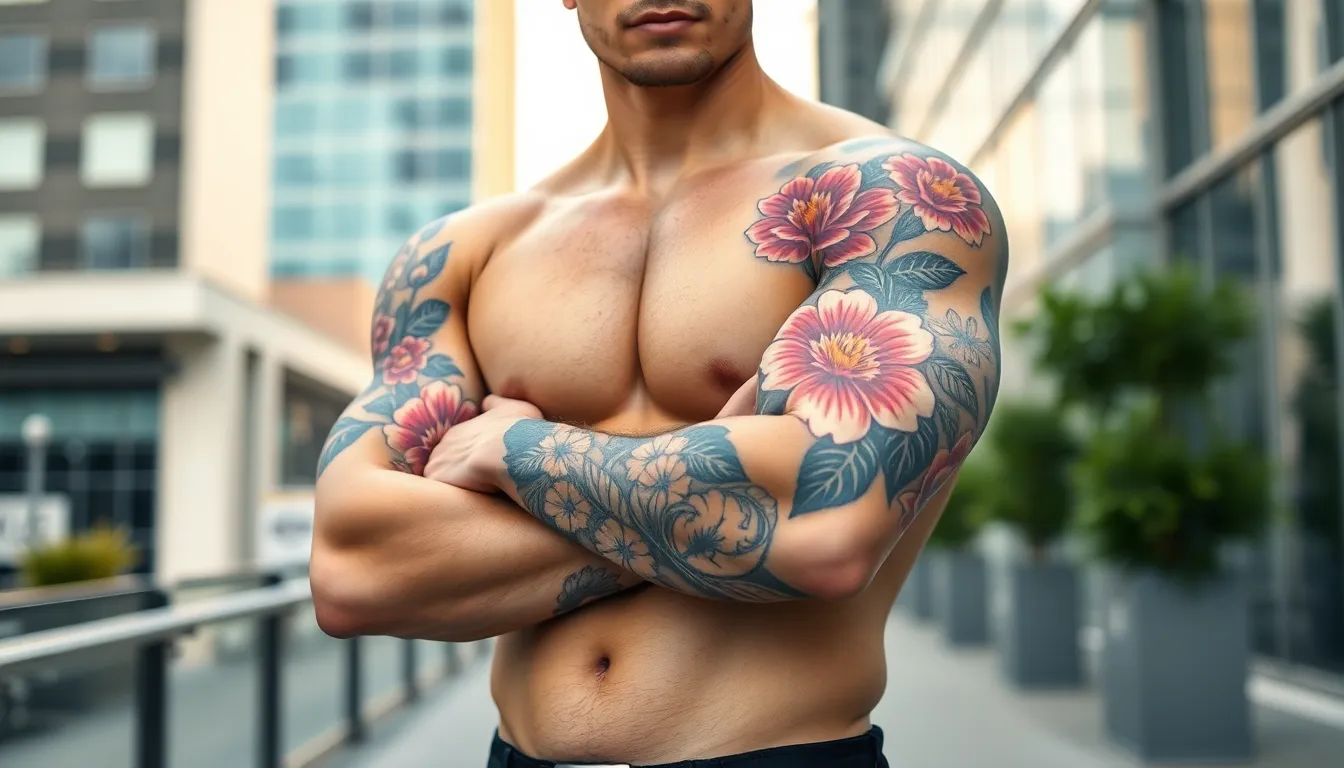
We’re witnessing an exciting evolution in Japanese flower tattoos as contemporary artists blend traditional motifs with cutting-edge techniques. These innovative approaches maintain cultural respect while creating fresh interpretations that appeal to modern men seeking unique body art.
Neo-Traditional Floral Sleeves
Neo-traditional sleeves revolutionize classic Japanese florals by incorporating bold outlines and rich shading techniques that emphasize masculine strength. Chrysanthemums and hibiscus flowers take center stage in these designs, symbolizing resilience and determination through dramatic contrast work. Artists use dark black ink paired with strategic negative space to make floral elements pop against the skin, creating visual depth that commands attention.
These powerful sleeve compositions often feature flowing maple leaves (momiji) that represent the passage of time and lovers, floating gracefully across the arm to symbolize change and delicacy in motion. Bold line work defines each petal while sophisticated shading techniques add dimensional quality that transforms traditional flowers into contemporary masterpieces. The neo-traditional approach allows for creative freedom while honoring the symbolic meanings behind each floral element.
Watercolor Japanese Flower Techniques
Watercolor techniques bring a soft, painterly quality to traditional Japanese flowers like lotus and sakura, creating an artistic contrast to more rigid conventional designs. This innovative style uses vibrant, flowing colors with intentionally less-defined lines to produce a serene, emotional effect that maintains cultural symbolism. Artists achieve fluid color transitions that mimic actual watercolor paintings, allowing for greater emotional expression within each design.
The watercolor approach creates beautiful bleeding effects between colors, giving lotus petals an ethereal quality that represents spiritual purity and enlightenment. Sakura blossoms rendered in watercolor style capture the ephemeral nature of cherry blossoms through soft pink and white gradients that seem to float on the skin. This technique works exceptionally well for men who appreciate artistic subtlety while wanting to honor Japanese floral traditions.
Abstract Geometric Flower Combinations
Abstract geometric combinations merge structured mathematical patterns with organic Japanese flower shapes, offering unique interpretations that fuse order with natural beauty. These masculine designs feature ever-changing lines and intentionally limited color palettes, sometimes using red sparingly for edgy effects that resemble unhealed scratches, reflecting untamed energy and strength. Geometric frameworks provide structure while traditional flowers like chrysanthemums and peonies maintain their symbolic meanings within modern contexts.
Artists create fascinating juxtapositions by placing precise geometric shapes alongside flowing floral forms, representing the balance between human design and natural beauty. These compositions often incorporate triangular or hexagonal patterns that frame traditional flowers, creating visual tension that draws the eye while respecting cultural symbolism. The abstract approach appeals to men seeking contemporary aesthetics without abandoning the deep meanings associated with Japanese floral imagery.
Placement Strategies for Japanese Flower Tattoos

Strategic placement transforms Japanese flower tattoos from simple designs into powerful artistic statements that enhance masculine appeal. We’ll explore how different body locations maximize the visual impact and cultural significance of these meaningful floral motifs.
Upper Body Positioning Options
Shoulder placements create natural canvases for flowing floral arrangements that complement muscle contours perfectly. Maple leaf motifs work exceptionally well across shoulders and torso areas, appearing to drift with wind movement while symbolizing life’s transitions. Cherry blossom branches extend beautifully from shoulder caps down to upper arms, creating ever-changing compositions that balance delicate beauty with masculine strength.
Chest positioning offers prime real estate for bold floral statements that command attention and respect. Chrysanthemum designs centered on the chest create powerful focal points, especially when incorporating traditional Imperial Family symbolism. Peony clusters work magnificently across the pectoral area, their layered petals creating depth through expert shading techniques.
Upper arm locations provide versatile spaces for both wraparound designs and focused artistic pieces. Lotus flowers positioned on the upper arm create striking visual balance when paired with complementary wave patterns. Traditional botan flowers use the arm’s natural curves to enhance their three dimensional appearance through strategic color placement.
Lower Body Design Considerations
Leg sleeve applications maximize the elongated canvas potential for comprehensive Japanese floral narratives. Cherry blossom branches wrap around calves and thighs, creating movement that follows natural muscle flow patterns. These placements allow for extensive storytelling through interconnected floral elements that span multiple body sections.
Calf positioning works particularly well for vertical floral compositions that emphasize height and elegance. Chrysanthemum clusters positioned on the calf create striking visual impact when walking, their detailed petals catching light dynamically. Traditional wave patterns complement floral elements perfectly in these locations, adding movement and cultural authenticity.
Thigh placements accommodate large scale peony designs that require substantial space for intricate detailing. These locations support bold color saturation and complex shading techniques that bring flowers to life. Dragon and peony combinations work exceptionally well on thigh areas, balancing mythical strength with delicate beauty.
Full Body Japanese Garden Concepts
Comprehensive garden narratives transform the entire body into living artwork that tells complete cultural stories. These expansive designs connect cherry blossoms, chrysanthemums, and lotus flowers through flowing wind patterns and traditional wave motifs. Back pieces serve as primary canvases, extending into shoulder areas and down arms to create cohesive artistic environments.
Interconnected floral systems use strategic placement to create visual flow between different body sections seamlessly. Maple leaves appear to blow from back pieces across shoulders, while cherry blossom petals seem to fall naturally down arms and legs. These designs require careful planning to ensure each section contributes to the overall garden narrative.
Traditional element integration incorporates koi fish, dragons, and samurai imagery throughout the floral industry for complete cultural authenticity. Wind bars and wave patterns serve as connecting elements that unify separate floral clusters into one harmonious composition. Color coordination across all body sections creates visual cohesion that honors traditional irezumi principles while making powerful personal statements.
Color Palettes and Styling Techniques
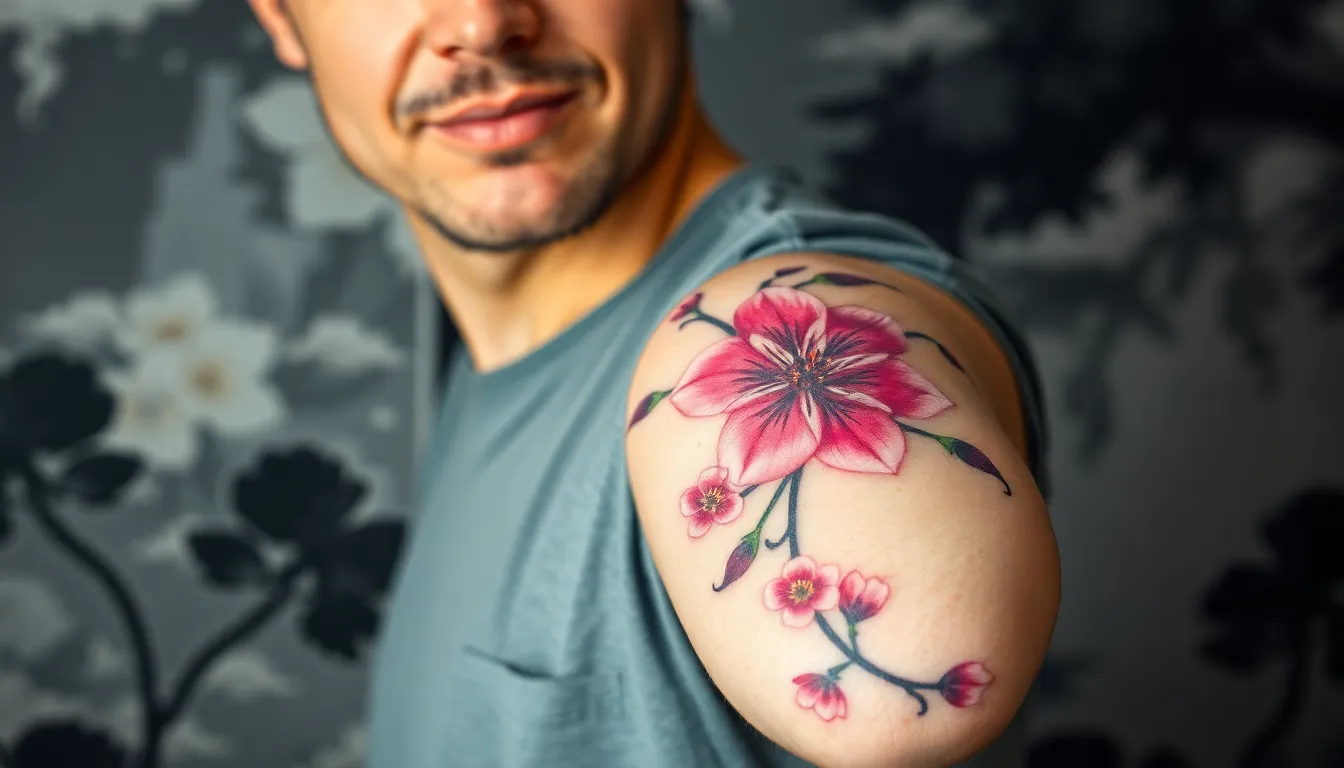
The artistic foundation of Japanese flower tattoos relies heavily on color choices and rendering techniques that honor traditional irezumi while embracing contemporary aesthetics.
Traditional Japanese Color Schemes
Traditional Japanese flower tattoos showcase vibrant, rich colors that carry deep symbolic meaning within each design. Cherry blossoms feature soft pink hues that beautifully capture the fleeting nature of life, while peonies burst with bold reds and deep pinks to represent wealth, prosperity, and masculine spirit. Maple leaves traditionally display striking reds and oranges that symbolize time’s passage and romantic love.
Artists apply these colors vividly to create ever-changing contrasts that make floral elements stand out within larger compositions. We often see these designs enhanced with natural elements like waves, clouds, and traditional motifs that complement the central flowers. The color application follows traditional irezumi techniques that emphasize symbolic significance over realistic representation.
Modern Monochromatic Approaches
Contemporary Japanese flower tattoos for men increasingly embrace black and gray color schemes that deliver sophisticated masculine aesthetics. This monochromatic approach emphasizes shading and contrast over traditional bright colors, focusing on texture and form rather than symbolic color meanings. Black and gray cherry blossoms and peonies create edgy, modern looks that blend realism with stylized elements.
Artists use this approach to create sleek, contemporary aesthetics while maintaining respect for traditional motifs. We find that monochromatic designs appeal particularly to professional men who prefer subtle elegance over bold color statements. The technique allows for intricate shading work that captures lifelike beauty and personal transformation themes.
Realistic Versus Stylized Rendering
Japanese flower tattoos range from highly stylized traditional designs to more realistic contemporary interpretations that serve different aesthetic purposes. Stylized flowers feature exaggerated sizes and forms with bold outlines and flat color areas that fit traditional irezumi style. These designs position flowers as symbolic elements within larger mythical scenes that emphasize cultural narrative and aesthetic beauty.
Realistic renderings incorporate detailed shading and delicate petal work that capture lifelike subtlety and natural beauty. Modern tattoos often use realistic techniques, especially in black and gray designs, to symbolize personal growth and inner transformation. We see artists blending both approaches to create unique pieces that honor tradition while expressing individual stories through contemporary techniques.
Cultural Significance and Symbolism
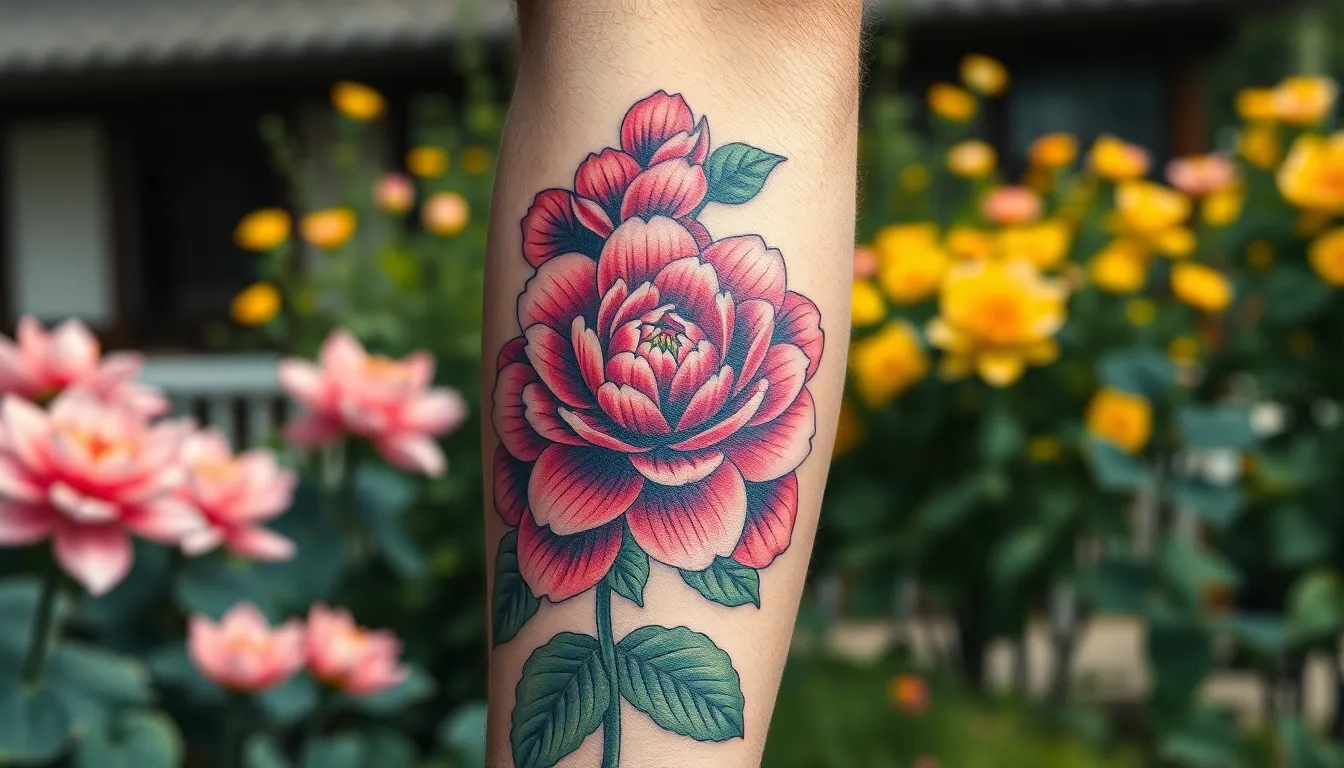
We explore the deeper meanings behind Japanese flower tattoos that extend far beyond mere decoration. These designs honor centuries of cultural tradition where flowers represent profound spiritual values rooted in Buddhist beliefs and samurai heritage.
Seasonal Flower Meanings
Different flowers carry distinct symbolic meanings tied to Japan’s seasonal cycles and life philosophies. Peonies symbolize wealth, prosperity, beauty, and the transitory nature of existence, making them powerful choices for men seeking tattoos that represent success and awareness of life’s fleeting moments. Maple leaves represent love, peace, harmony, and the passing of time, often depicted in rich autumnal colors that capture nature’s groundbreaking beauty.
Lotus flowers embody enlightenment, perseverance, and rebirth, signifying resilience in overcoming life’s struggles through their ability to bloom from muddy waters. Orchids, particularly the Neofinetia falcata species, historically represented wealth, nobility, and bravery within samurai culture, where warriors sought these flowers as symbols of courage and honor.
Masculine Interpretations of Floral Symbols
Unlike Western traditions where flowers often carry feminine associations, Japanese floral tattoos emphasize distinctly masculine virtues and warrior qualities. Lotus flowers serve as prime examples, symbolizing perseverance and spiritual enlightenment that align with male strength and endurance. Orchids convey samurai bravery and honor, connecting modern men to ancient warrior traditions through meaningful body art.
Peonies represent wealth and power, attributes traditionally linked to masculine strength and social status in Japanese society. These floral tattoos frequently embody the complete life cycle of birth, death, and rebirth, reflecting endurance and resilience that cultures worldwide admire in men.
Respectful Cultural Representation
Choosing Japanese flower tattoos requires understanding and respecting their deep cultural context beyond surface aesthetics. We must honor the historical and spiritual meanings embedded in these symbols while avoiding trivialization or misappropriation of sacred Japanese imagery. Buddhist influences permeate these designs, linking flowers to purity, spirituality, and moral values that deserve thoughtful consideration.
Samurai heritage connects many floral symbols to concepts of courage, honor, and nobility that should be approached with cultural sensitivity. Working with knowledgeable tattoo artists who understand traditional Japanese symbolism ensures authentic representation that honors rather than exploits this rich cultural heritage.
Conclusion
Japanese flower tattoos offer men a unique opportunity to embrace both beauty and strength through meaningful body art. We’ve explored how these designs transcend traditional gender boundaries while maintaining their cultural authenticity and masculine appeal.
The journey from selecting your flower to working with skilled artists requires patience and respect for the art form. Each bloom carries centuries of tradition and symbolism that can’t be replicated through shortcuts or casual approaches.
Whether you’re drawn to the ephemeral beauty of cherry blossoms or the noble strength of chrysanthemums your choice should reflect your personal story. These tattoos aren’t just decorative elements—they’re lasting statements of character and cultural appreciation.
We encourage you to take time researching artists who specialize in traditional Japanese techniques. The investment in authentic craftsmanship will ensure your tattoo honors both the cultural heritage and your individual expression for years to come.
Frequently Asked Questions
What do Japanese flower tattoos symbolize for men?
Japanese flower tattoos for men carry powerful masculine meanings rooted in samurai heritage and Buddhist beliefs. Cherry blossoms represent life’s fleeting beauty, chrysanthemums symbolize honor and loyalty, lotus flowers embody rebirth and spiritual strength, while peonies represent wealth and bravery. These designs convey distinctly masculine virtues unlike Western floral traditions.
Are cherry blossom tattoos suitable for men?
Yes, cherry blossom tattoos are highly suitable for men in Japanese culture. They represent the balance between delicate beauty and powerful symbolism, embodying the samurai concept of life’s ephemeral nature. Bold sakura sleeve designs and minimalist accents offer masculine appeal while maintaining cultural authenticity and meaningful symbolism.
What’s the significance of chrysanthemum tattoos in Japanese culture?
Chrysanthemum tattoos hold deep cultural significance, representing longevity, nobility, honor, and resilience. They’re connected to the Japanese Imperial Family and samurai heritage. The imperial chrysanthemum crest symbolizes strength and cultural pride, making these intricate flowers among the most meaningful Japanese floral designs for men.
Where should I place my Japanese flower tattoo?
Strategic placement enhances visual impact and cultural significance. Upper body options like shoulders and chest create natural canvases for bold statements. Lower body placements including leg sleeves and calf positioning work well for dynamic narratives. Full-body Japanese garden designs offer cohesive artistic environments with interconnected elements.
What’s the difference between traditional and modern Japanese flower tattoos?
Traditional Japanese flower tattoos use authentic irezumi techniques with vibrant colors and cultural symbolism. Modern fusion approaches incorporate neo-traditional elements, watercolor techniques, and geometric patterns while maintaining cultural significance. Both styles honor the artistic heritage but offer different aesthetic appeals for contemporary men.
How do I ensure my Japanese flower tattoo is culturally respectful?
To ensure cultural respect, collaborate with knowledgeable tattoo artists who understand Japanese traditions. Research the specific meanings behind chosen flowers, avoid mixing incompatible symbols, and understand the cultural context rather than treating them as mere decorative elements. Authentic representation requires respecting the art form’s rich heritage.
Can Japanese flower tattoos be combined with other elements?
Yes, Japanese flower tattoos work beautifully with complementary traditional elements. Popular combinations include lotus with koi fish, peonies with dragons, camellia with samurai imagery, and cherry blossoms with wave patterns. These combinations create powerful storytelling compositions while maintaining cultural authenticity and enhanced masculine appeal.
What colors work best for Japanese flower tattoos?
Traditional Japanese color schemes use vibrant hues with deep symbolic meanings – reds, purples, and golds for peonies, soft pinks for cherry blossoms. Modern approaches favor monochromatic black and gray designs emphasizing shading and texture. Both color palettes honor the art form while offering different aesthetic appeals for personal preference.

